Analysis: The West Gate Bridge Collapse & Engineering Responsibility
VerifiedAdded on 2023/06/03
|10
|2527
|415
Case Study
AI Summary
This case study examines the collapse of the West Gate Bridge in Australia, a significant engineering failure that resulted in the loss of 35 lives. The study delves into the findings of the royal commission, which attributed the collapse to structural design flaws and errors in the construction process, including the use of heavy concrete blocks and inadequate solutions to alignment issues. It highlights the failure of engineers to address critical warning signs and prioritize safety over project completion, emphasizing the importance of ethical conduct and professional responsibility in engineering. The study contrasts these failures with how professional engineers should act, stressing the need to prioritize human life, adhere to legislative requirements, and ensure thorough risk assessment and problem rectification. Ultimately, the case study underscores the lessons learned from the tragedy and their impact on modern engineering practices, particularly in ethics and safety.
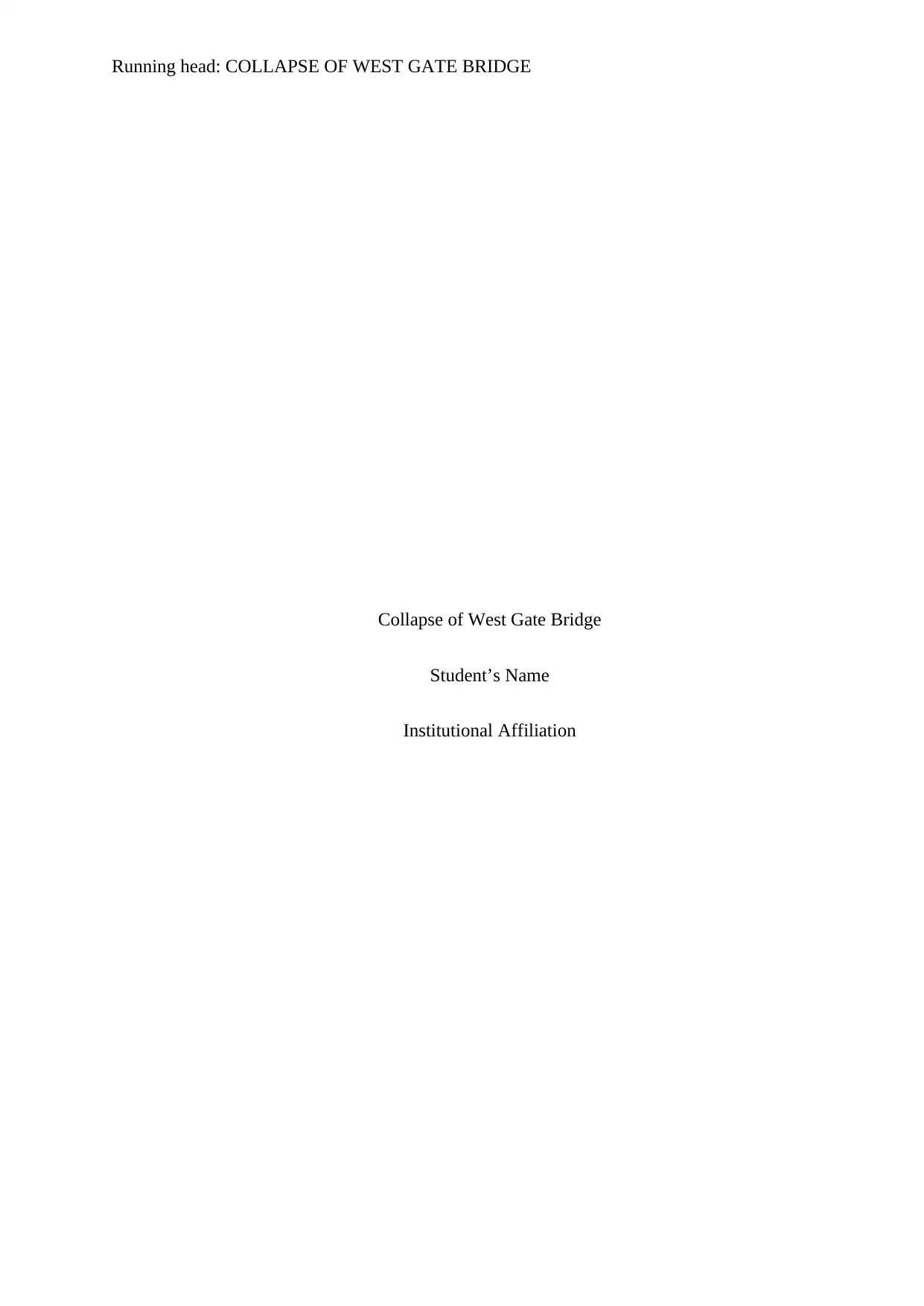
Running head: COLLAPSE OF WEST GATE BRIDGE
Collapse of West Gate Bridge
Student’s Name
Institutional Affiliation
Collapse of West Gate Bridge
Student’s Name
Institutional Affiliation
Paraphrase This Document
Need a fresh take? Get an instant paraphrase of this document with our AI Paraphraser
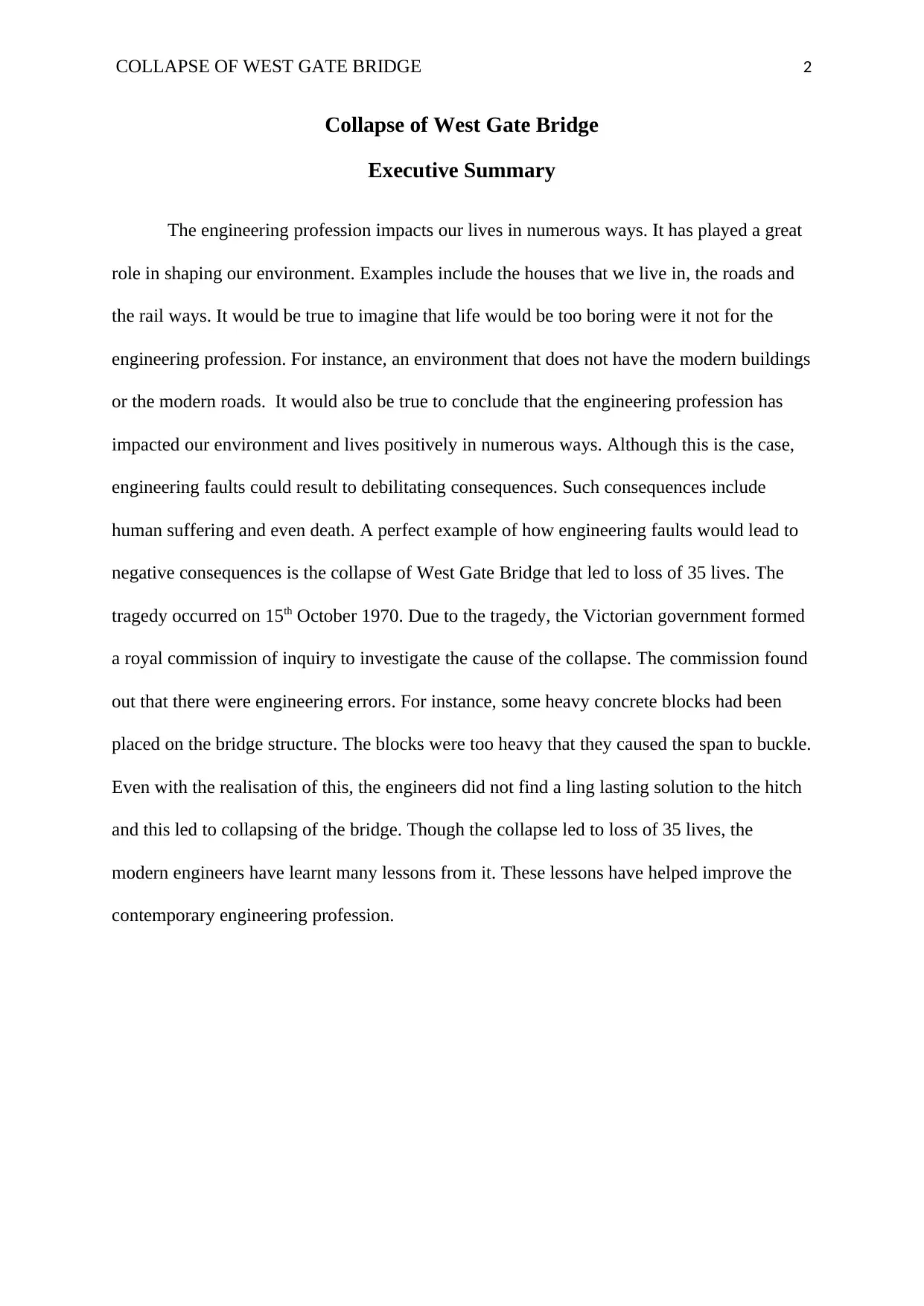
COLLAPSE OF WEST GATE BRIDGE 2
Collapse of West Gate Bridge
Executive Summary
The engineering profession impacts our lives in numerous ways. It has played a great
role in shaping our environment. Examples include the houses that we live in, the roads and
the rail ways. It would be true to imagine that life would be too boring were it not for the
engineering profession. For instance, an environment that does not have the modern buildings
or the modern roads. It would also be true to conclude that the engineering profession has
impacted our environment and lives positively in numerous ways. Although this is the case,
engineering faults could result to debilitating consequences. Such consequences include
human suffering and even death. A perfect example of how engineering faults would lead to
negative consequences is the collapse of West Gate Bridge that led to loss of 35 lives. The
tragedy occurred on 15th October 1970. Due to the tragedy, the Victorian government formed
a royal commission of inquiry to investigate the cause of the collapse. The commission found
out that there were engineering errors. For instance, some heavy concrete blocks had been
placed on the bridge structure. The blocks were too heavy that they caused the span to buckle.
Even with the realisation of this, the engineers did not find a ling lasting solution to the hitch
and this led to collapsing of the bridge. Though the collapse led to loss of 35 lives, the
modern engineers have learnt many lessons from it. These lessons have helped improve the
contemporary engineering profession.
Collapse of West Gate Bridge
Executive Summary
The engineering profession impacts our lives in numerous ways. It has played a great
role in shaping our environment. Examples include the houses that we live in, the roads and
the rail ways. It would be true to imagine that life would be too boring were it not for the
engineering profession. For instance, an environment that does not have the modern buildings
or the modern roads. It would also be true to conclude that the engineering profession has
impacted our environment and lives positively in numerous ways. Although this is the case,
engineering faults could result to debilitating consequences. Such consequences include
human suffering and even death. A perfect example of how engineering faults would lead to
negative consequences is the collapse of West Gate Bridge that led to loss of 35 lives. The
tragedy occurred on 15th October 1970. Due to the tragedy, the Victorian government formed
a royal commission of inquiry to investigate the cause of the collapse. The commission found
out that there were engineering errors. For instance, some heavy concrete blocks had been
placed on the bridge structure. The blocks were too heavy that they caused the span to buckle.
Even with the realisation of this, the engineers did not find a ling lasting solution to the hitch
and this led to collapsing of the bridge. Though the collapse led to loss of 35 lives, the
modern engineers have learnt many lessons from it. These lessons have helped improve the
contemporary engineering profession.
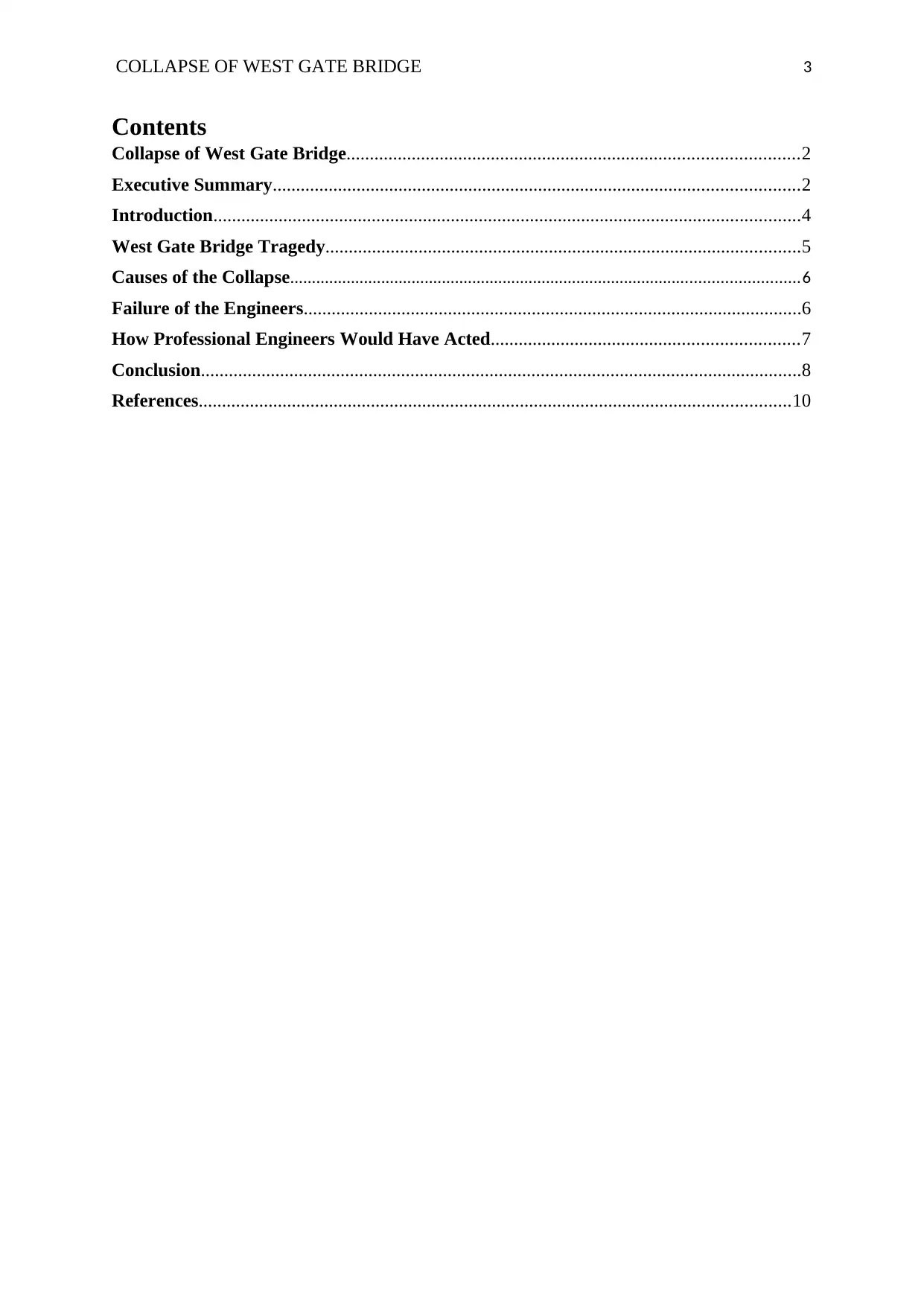
COLLAPSE OF WEST GATE BRIDGE 3
Contents
Collapse of West Gate Bridge.................................................................................................2
Executive Summary.................................................................................................................2
Introduction..............................................................................................................................4
West Gate Bridge Tragedy......................................................................................................5
Causes of the Collapse.....................................................................................................................6
Failure of the Engineers...........................................................................................................6
How Professional Engineers Would Have Acted..................................................................7
Conclusion.................................................................................................................................8
References...............................................................................................................................10
Contents
Collapse of West Gate Bridge.................................................................................................2
Executive Summary.................................................................................................................2
Introduction..............................................................................................................................4
West Gate Bridge Tragedy......................................................................................................5
Causes of the Collapse.....................................................................................................................6
Failure of the Engineers...........................................................................................................6
How Professional Engineers Would Have Acted..................................................................7
Conclusion.................................................................................................................................8
References...............................................................................................................................10
⊘ This is a preview!⊘
Do you want full access?
Subscribe today to unlock all pages.

Trusted by 1+ million students worldwide
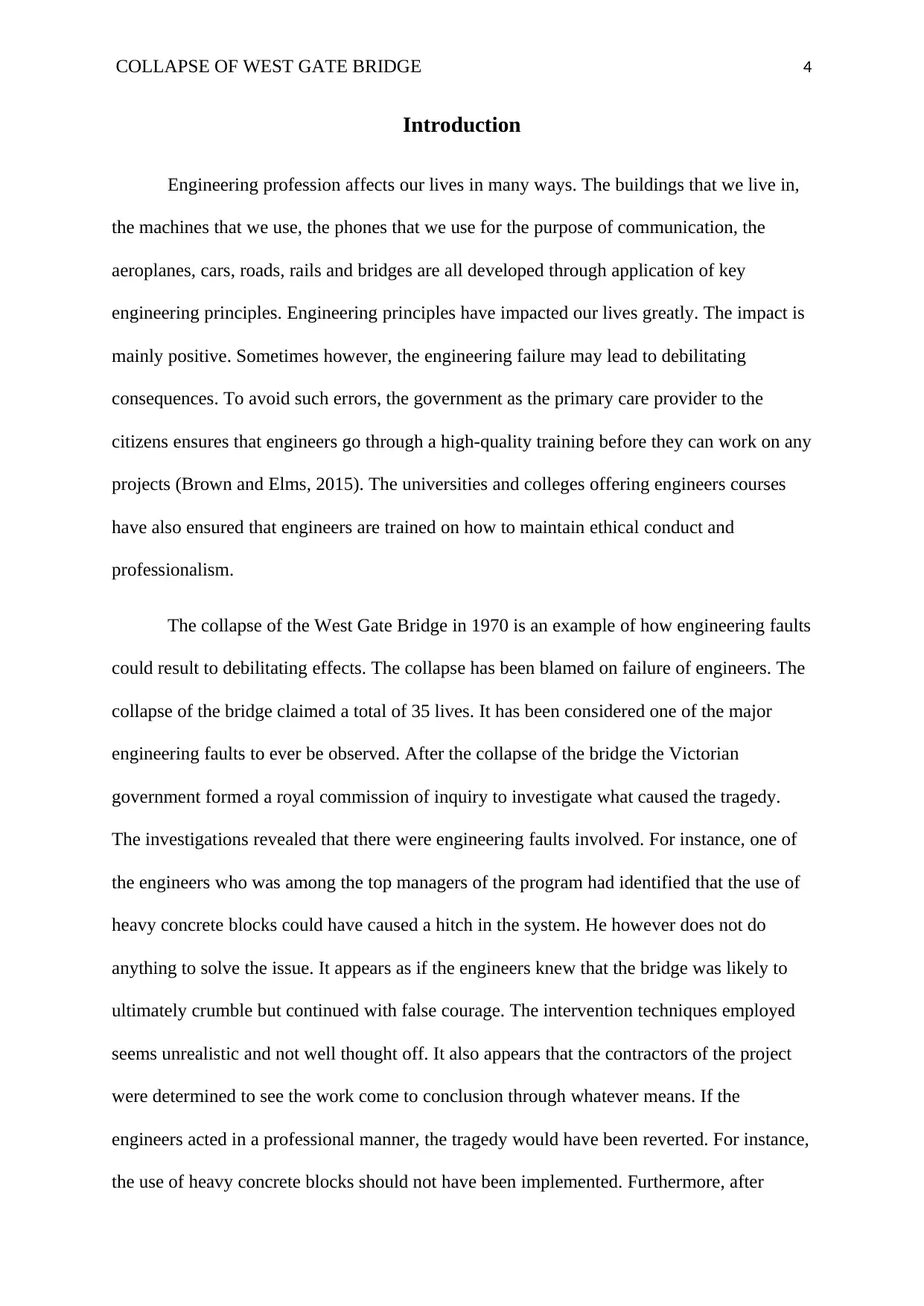
COLLAPSE OF WEST GATE BRIDGE 4
Introduction
Engineering profession affects our lives in many ways. The buildings that we live in,
the machines that we use, the phones that we use for the purpose of communication, the
aeroplanes, cars, roads, rails and bridges are all developed through application of key
engineering principles. Engineering principles have impacted our lives greatly. The impact is
mainly positive. Sometimes however, the engineering failure may lead to debilitating
consequences. To avoid such errors, the government as the primary care provider to the
citizens ensures that engineers go through a high-quality training before they can work on any
projects (Brown and Elms, 2015). The universities and colleges offering engineers courses
have also ensured that engineers are trained on how to maintain ethical conduct and
professionalism.
The collapse of the West Gate Bridge in 1970 is an example of how engineering faults
could result to debilitating effects. The collapse has been blamed on failure of engineers. The
collapse of the bridge claimed a total of 35 lives. It has been considered one of the major
engineering faults to ever be observed. After the collapse of the bridge the Victorian
government formed a royal commission of inquiry to investigate what caused the tragedy.
The investigations revealed that there were engineering faults involved. For instance, one of
the engineers who was among the top managers of the program had identified that the use of
heavy concrete blocks could have caused a hitch in the system. He however does not do
anything to solve the issue. It appears as if the engineers knew that the bridge was likely to
ultimately crumble but continued with false courage. The intervention techniques employed
seems unrealistic and not well thought off. It also appears that the contractors of the project
were determined to see the work come to conclusion through whatever means. If the
engineers acted in a professional manner, the tragedy would have been reverted. For instance,
the use of heavy concrete blocks should not have been implemented. Furthermore, after
Introduction
Engineering profession affects our lives in many ways. The buildings that we live in,
the machines that we use, the phones that we use for the purpose of communication, the
aeroplanes, cars, roads, rails and bridges are all developed through application of key
engineering principles. Engineering principles have impacted our lives greatly. The impact is
mainly positive. Sometimes however, the engineering failure may lead to debilitating
consequences. To avoid such errors, the government as the primary care provider to the
citizens ensures that engineers go through a high-quality training before they can work on any
projects (Brown and Elms, 2015). The universities and colleges offering engineers courses
have also ensured that engineers are trained on how to maintain ethical conduct and
professionalism.
The collapse of the West Gate Bridge in 1970 is an example of how engineering faults
could result to debilitating effects. The collapse has been blamed on failure of engineers. The
collapse of the bridge claimed a total of 35 lives. It has been considered one of the major
engineering faults to ever be observed. After the collapse of the bridge the Victorian
government formed a royal commission of inquiry to investigate what caused the tragedy.
The investigations revealed that there were engineering faults involved. For instance, one of
the engineers who was among the top managers of the program had identified that the use of
heavy concrete blocks could have caused a hitch in the system. He however does not do
anything to solve the issue. It appears as if the engineers knew that the bridge was likely to
ultimately crumble but continued with false courage. The intervention techniques employed
seems unrealistic and not well thought off. It also appears that the contractors of the project
were determined to see the work come to conclusion through whatever means. If the
engineers acted in a professional manner, the tragedy would have been reverted. For instance,
the use of heavy concrete blocks should not have been implemented. Furthermore, after
Paraphrase This Document
Need a fresh take? Get an instant paraphrase of this document with our AI Paraphraser
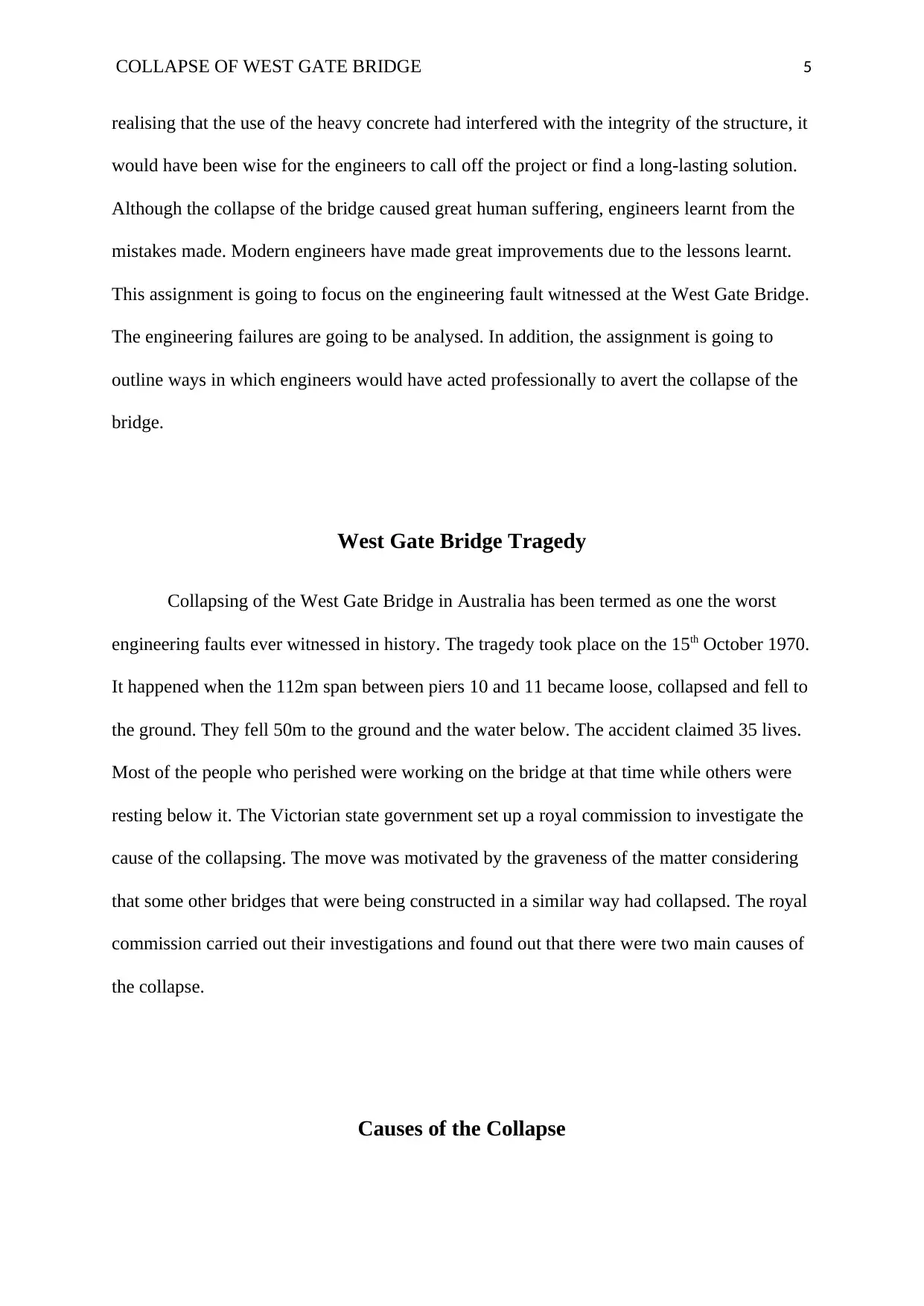
COLLAPSE OF WEST GATE BRIDGE 5
realising that the use of the heavy concrete had interfered with the integrity of the structure, it
would have been wise for the engineers to call off the project or find a long-lasting solution.
Although the collapse of the bridge caused great human suffering, engineers learnt from the
mistakes made. Modern engineers have made great improvements due to the lessons learnt.
This assignment is going to focus on the engineering fault witnessed at the West Gate Bridge.
The engineering failures are going to be analysed. In addition, the assignment is going to
outline ways in which engineers would have acted professionally to avert the collapse of the
bridge.
West Gate Bridge Tragedy
Collapsing of the West Gate Bridge in Australia has been termed as one the worst
engineering faults ever witnessed in history. The tragedy took place on the 15th October 1970.
It happened when the 112m span between piers 10 and 11 became loose, collapsed and fell to
the ground. They fell 50m to the ground and the water below. The accident claimed 35 lives.
Most of the people who perished were working on the bridge at that time while others were
resting below it. The Victorian state government set up a royal commission to investigate the
cause of the collapsing. The move was motivated by the graveness of the matter considering
that some other bridges that were being constructed in a similar way had collapsed. The royal
commission carried out their investigations and found out that there were two main causes of
the collapse.
Causes of the Collapse
realising that the use of the heavy concrete had interfered with the integrity of the structure, it
would have been wise for the engineers to call off the project or find a long-lasting solution.
Although the collapse of the bridge caused great human suffering, engineers learnt from the
mistakes made. Modern engineers have made great improvements due to the lessons learnt.
This assignment is going to focus on the engineering fault witnessed at the West Gate Bridge.
The engineering failures are going to be analysed. In addition, the assignment is going to
outline ways in which engineers would have acted professionally to avert the collapse of the
bridge.
West Gate Bridge Tragedy
Collapsing of the West Gate Bridge in Australia has been termed as one the worst
engineering faults ever witnessed in history. The tragedy took place on the 15th October 1970.
It happened when the 112m span between piers 10 and 11 became loose, collapsed and fell to
the ground. They fell 50m to the ground and the water below. The accident claimed 35 lives.
Most of the people who perished were working on the bridge at that time while others were
resting below it. The Victorian state government set up a royal commission to investigate the
cause of the collapsing. The move was motivated by the graveness of the matter considering
that some other bridges that were being constructed in a similar way had collapsed. The royal
commission carried out their investigations and found out that there were two main causes of
the collapse.
Causes of the Collapse
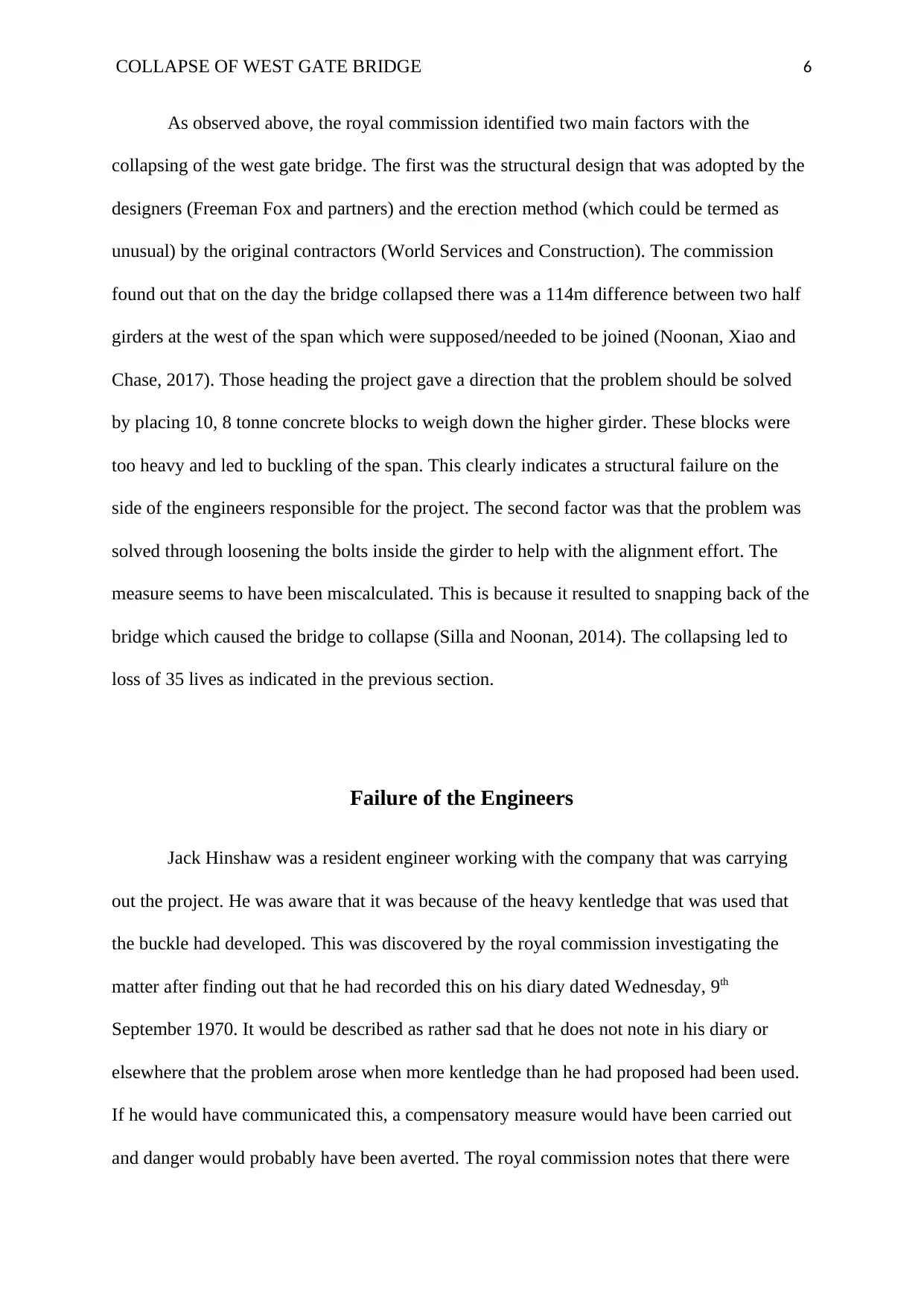
COLLAPSE OF WEST GATE BRIDGE 6
As observed above, the royal commission identified two main factors with the
collapsing of the west gate bridge. The first was the structural design that was adopted by the
designers (Freeman Fox and partners) and the erection method (which could be termed as
unusual) by the original contractors (World Services and Construction). The commission
found out that on the day the bridge collapsed there was a 114m difference between two half
girders at the west of the span which were supposed/needed to be joined (Noonan, Xiao and
Chase, 2017). Those heading the project gave a direction that the problem should be solved
by placing 10, 8 tonne concrete blocks to weigh down the higher girder. These blocks were
too heavy and led to buckling of the span. This clearly indicates a structural failure on the
side of the engineers responsible for the project. The second factor was that the problem was
solved through loosening the bolts inside the girder to help with the alignment effort. The
measure seems to have been miscalculated. This is because it resulted to snapping back of the
bridge which caused the bridge to collapse (Silla and Noonan, 2014). The collapsing led to
loss of 35 lives as indicated in the previous section.
Failure of the Engineers
Jack Hinshaw was a resident engineer working with the company that was carrying
out the project. He was aware that it was because of the heavy kentledge that was used that
the buckle had developed. This was discovered by the royal commission investigating the
matter after finding out that he had recorded this on his diary dated Wednesday, 9th
September 1970. It would be described as rather sad that he does not note in his diary or
elsewhere that the problem arose when more kentledge than he had proposed had been used.
If he would have communicated this, a compensatory measure would have been carried out
and danger would probably have been averted. The royal commission notes that there were
As observed above, the royal commission identified two main factors with the
collapsing of the west gate bridge. The first was the structural design that was adopted by the
designers (Freeman Fox and partners) and the erection method (which could be termed as
unusual) by the original contractors (World Services and Construction). The commission
found out that on the day the bridge collapsed there was a 114m difference between two half
girders at the west of the span which were supposed/needed to be joined (Noonan, Xiao and
Chase, 2017). Those heading the project gave a direction that the problem should be solved
by placing 10, 8 tonne concrete blocks to weigh down the higher girder. These blocks were
too heavy and led to buckling of the span. This clearly indicates a structural failure on the
side of the engineers responsible for the project. The second factor was that the problem was
solved through loosening the bolts inside the girder to help with the alignment effort. The
measure seems to have been miscalculated. This is because it resulted to snapping back of the
bridge which caused the bridge to collapse (Silla and Noonan, 2014). The collapsing led to
loss of 35 lives as indicated in the previous section.
Failure of the Engineers
Jack Hinshaw was a resident engineer working with the company that was carrying
out the project. He was aware that it was because of the heavy kentledge that was used that
the buckle had developed. This was discovered by the royal commission investigating the
matter after finding out that he had recorded this on his diary dated Wednesday, 9th
September 1970. It would be described as rather sad that he does not note in his diary or
elsewhere that the problem arose when more kentledge than he had proposed had been used.
If he would have communicated this, a compensatory measure would have been carried out
and danger would probably have been averted. The royal commission notes that there were
⊘ This is a preview!⊘
Do you want full access?
Subscribe today to unlock all pages.

Trusted by 1+ million students worldwide
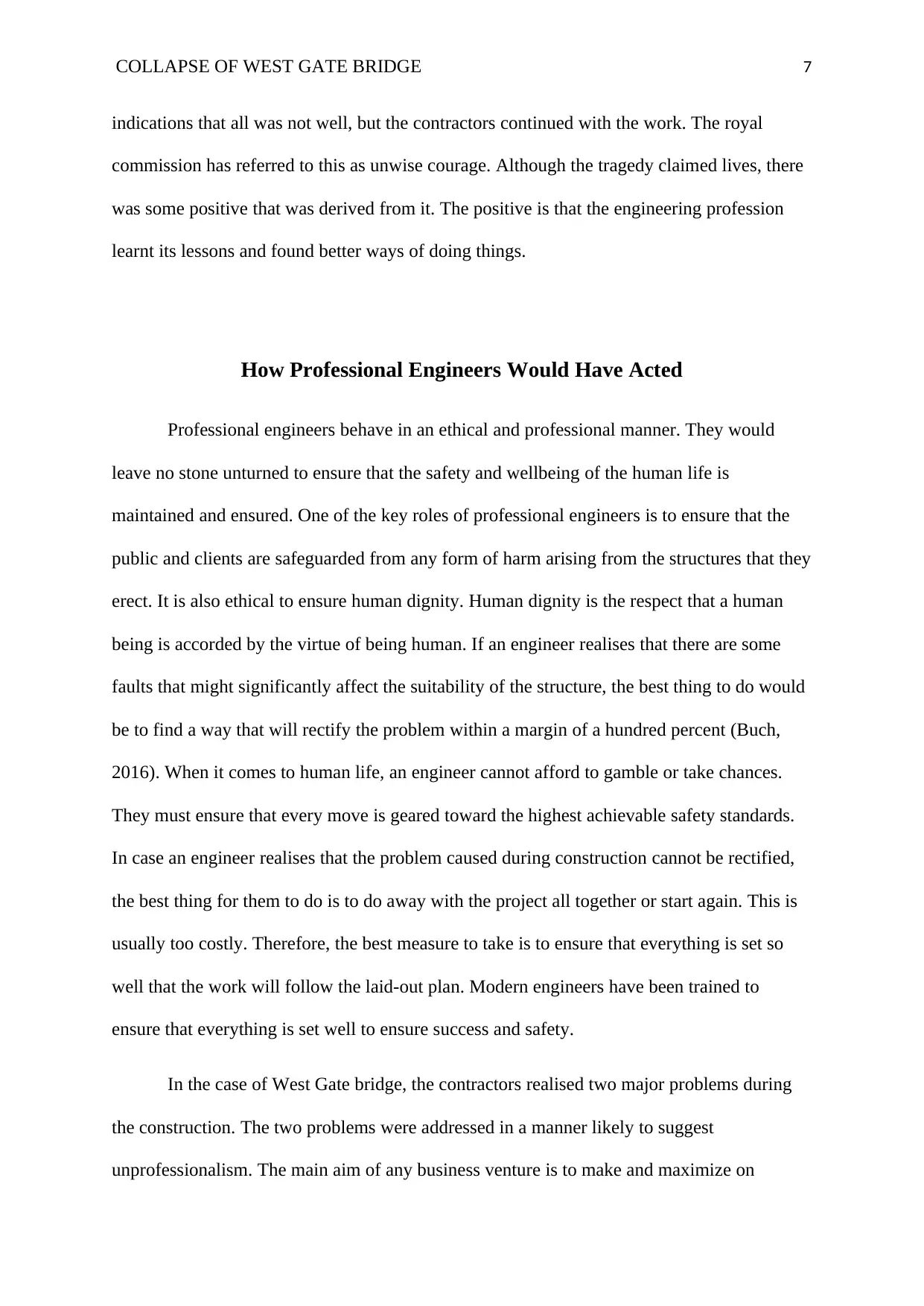
COLLAPSE OF WEST GATE BRIDGE 7
indications that all was not well, but the contractors continued with the work. The royal
commission has referred to this as unwise courage. Although the tragedy claimed lives, there
was some positive that was derived from it. The positive is that the engineering profession
learnt its lessons and found better ways of doing things.
How Professional Engineers Would Have Acted
Professional engineers behave in an ethical and professional manner. They would
leave no stone unturned to ensure that the safety and wellbeing of the human life is
maintained and ensured. One of the key roles of professional engineers is to ensure that the
public and clients are safeguarded from any form of harm arising from the structures that they
erect. It is also ethical to ensure human dignity. Human dignity is the respect that a human
being is accorded by the virtue of being human. If an engineer realises that there are some
faults that might significantly affect the suitability of the structure, the best thing to do would
be to find a way that will rectify the problem within a margin of a hundred percent (Buch,
2016). When it comes to human life, an engineer cannot afford to gamble or take chances.
They must ensure that every move is geared toward the highest achievable safety standards.
In case an engineer realises that the problem caused during construction cannot be rectified,
the best thing for them to do is to do away with the project all together or start again. This is
usually too costly. Therefore, the best measure to take is to ensure that everything is set so
well that the work will follow the laid-out plan. Modern engineers have been trained to
ensure that everything is set well to ensure success and safety.
In the case of West Gate bridge, the contractors realised two major problems during
the construction. The two problems were addressed in a manner likely to suggest
unprofessionalism. The main aim of any business venture is to make and maximize on
indications that all was not well, but the contractors continued with the work. The royal
commission has referred to this as unwise courage. Although the tragedy claimed lives, there
was some positive that was derived from it. The positive is that the engineering profession
learnt its lessons and found better ways of doing things.
How Professional Engineers Would Have Acted
Professional engineers behave in an ethical and professional manner. They would
leave no stone unturned to ensure that the safety and wellbeing of the human life is
maintained and ensured. One of the key roles of professional engineers is to ensure that the
public and clients are safeguarded from any form of harm arising from the structures that they
erect. It is also ethical to ensure human dignity. Human dignity is the respect that a human
being is accorded by the virtue of being human. If an engineer realises that there are some
faults that might significantly affect the suitability of the structure, the best thing to do would
be to find a way that will rectify the problem within a margin of a hundred percent (Buch,
2016). When it comes to human life, an engineer cannot afford to gamble or take chances.
They must ensure that every move is geared toward the highest achievable safety standards.
In case an engineer realises that the problem caused during construction cannot be rectified,
the best thing for them to do is to do away with the project all together or start again. This is
usually too costly. Therefore, the best measure to take is to ensure that everything is set so
well that the work will follow the laid-out plan. Modern engineers have been trained to
ensure that everything is set well to ensure success and safety.
In the case of West Gate bridge, the contractors realised two major problems during
the construction. The two problems were addressed in a manner likely to suggest
unprofessionalism. The main aim of any business venture is to make and maximize on
Paraphrase This Document
Need a fresh take? Get an instant paraphrase of this document with our AI Paraphraser
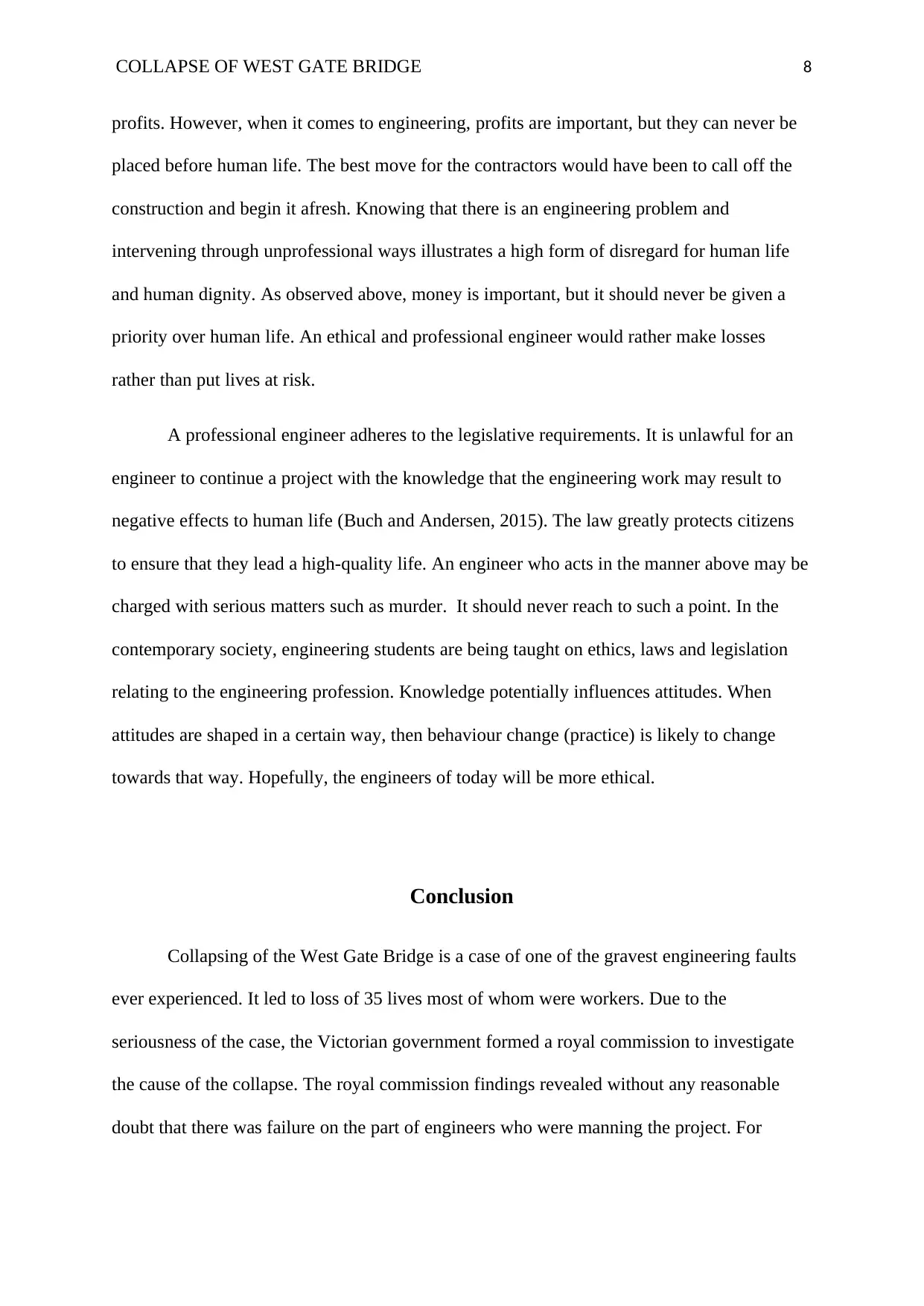
COLLAPSE OF WEST GATE BRIDGE 8
profits. However, when it comes to engineering, profits are important, but they can never be
placed before human life. The best move for the contractors would have been to call off the
construction and begin it afresh. Knowing that there is an engineering problem and
intervening through unprofessional ways illustrates a high form of disregard for human life
and human dignity. As observed above, money is important, but it should never be given a
priority over human life. An ethical and professional engineer would rather make losses
rather than put lives at risk.
A professional engineer adheres to the legislative requirements. It is unlawful for an
engineer to continue a project with the knowledge that the engineering work may result to
negative effects to human life (Buch and Andersen, 2015). The law greatly protects citizens
to ensure that they lead a high-quality life. An engineer who acts in the manner above may be
charged with serious matters such as murder. It should never reach to such a point. In the
contemporary society, engineering students are being taught on ethics, laws and legislation
relating to the engineering profession. Knowledge potentially influences attitudes. When
attitudes are shaped in a certain way, then behaviour change (practice) is likely to change
towards that way. Hopefully, the engineers of today will be more ethical.
Conclusion
Collapsing of the West Gate Bridge is a case of one of the gravest engineering faults
ever experienced. It led to loss of 35 lives most of whom were workers. Due to the
seriousness of the case, the Victorian government formed a royal commission to investigate
the cause of the collapse. The royal commission findings revealed without any reasonable
doubt that there was failure on the part of engineers who were manning the project. For
profits. However, when it comes to engineering, profits are important, but they can never be
placed before human life. The best move for the contractors would have been to call off the
construction and begin it afresh. Knowing that there is an engineering problem and
intervening through unprofessional ways illustrates a high form of disregard for human life
and human dignity. As observed above, money is important, but it should never be given a
priority over human life. An ethical and professional engineer would rather make losses
rather than put lives at risk.
A professional engineer adheres to the legislative requirements. It is unlawful for an
engineer to continue a project with the knowledge that the engineering work may result to
negative effects to human life (Buch and Andersen, 2015). The law greatly protects citizens
to ensure that they lead a high-quality life. An engineer who acts in the manner above may be
charged with serious matters such as murder. It should never reach to such a point. In the
contemporary society, engineering students are being taught on ethics, laws and legislation
relating to the engineering profession. Knowledge potentially influences attitudes. When
attitudes are shaped in a certain way, then behaviour change (practice) is likely to change
towards that way. Hopefully, the engineers of today will be more ethical.
Conclusion
Collapsing of the West Gate Bridge is a case of one of the gravest engineering faults
ever experienced. It led to loss of 35 lives most of whom were workers. Due to the
seriousness of the case, the Victorian government formed a royal commission to investigate
the cause of the collapse. The royal commission findings revealed without any reasonable
doubt that there was failure on the part of engineers who were manning the project. For
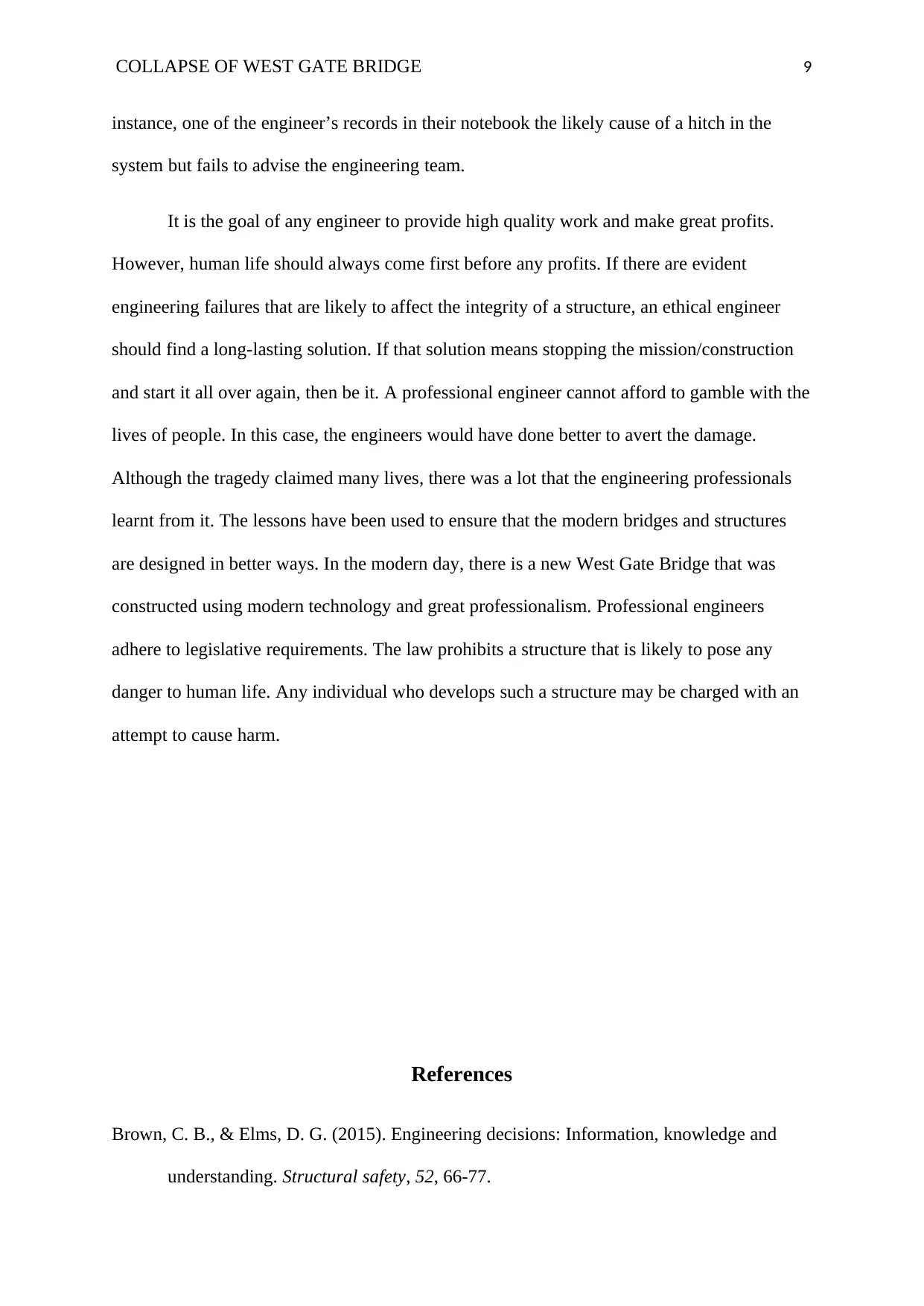
COLLAPSE OF WEST GATE BRIDGE 9
instance, one of the engineer’s records in their notebook the likely cause of a hitch in the
system but fails to advise the engineering team.
It is the goal of any engineer to provide high quality work and make great profits.
However, human life should always come first before any profits. If there are evident
engineering failures that are likely to affect the integrity of a structure, an ethical engineer
should find a long-lasting solution. If that solution means stopping the mission/construction
and start it all over again, then be it. A professional engineer cannot afford to gamble with the
lives of people. In this case, the engineers would have done better to avert the damage.
Although the tragedy claimed many lives, there was a lot that the engineering professionals
learnt from it. The lessons have been used to ensure that the modern bridges and structures
are designed in better ways. In the modern day, there is a new West Gate Bridge that was
constructed using modern technology and great professionalism. Professional engineers
adhere to legislative requirements. The law prohibits a structure that is likely to pose any
danger to human life. Any individual who develops such a structure may be charged with an
attempt to cause harm.
References
Brown, C. B., & Elms, D. G. (2015). Engineering decisions: Information, knowledge and
understanding. Structural safety, 52, 66-77.
instance, one of the engineer’s records in their notebook the likely cause of a hitch in the
system but fails to advise the engineering team.
It is the goal of any engineer to provide high quality work and make great profits.
However, human life should always come first before any profits. If there are evident
engineering failures that are likely to affect the integrity of a structure, an ethical engineer
should find a long-lasting solution. If that solution means stopping the mission/construction
and start it all over again, then be it. A professional engineer cannot afford to gamble with the
lives of people. In this case, the engineers would have done better to avert the damage.
Although the tragedy claimed many lives, there was a lot that the engineering professionals
learnt from it. The lessons have been used to ensure that the modern bridges and structures
are designed in better ways. In the modern day, there is a new West Gate Bridge that was
constructed using modern technology and great professionalism. Professional engineers
adhere to legislative requirements. The law prohibits a structure that is likely to pose any
danger to human life. Any individual who develops such a structure may be charged with an
attempt to cause harm.
References
Brown, C. B., & Elms, D. G. (2015). Engineering decisions: Information, knowledge and
understanding. Structural safety, 52, 66-77.
⊘ This is a preview!⊘
Do you want full access?
Subscribe today to unlock all pages.

Trusted by 1+ million students worldwide
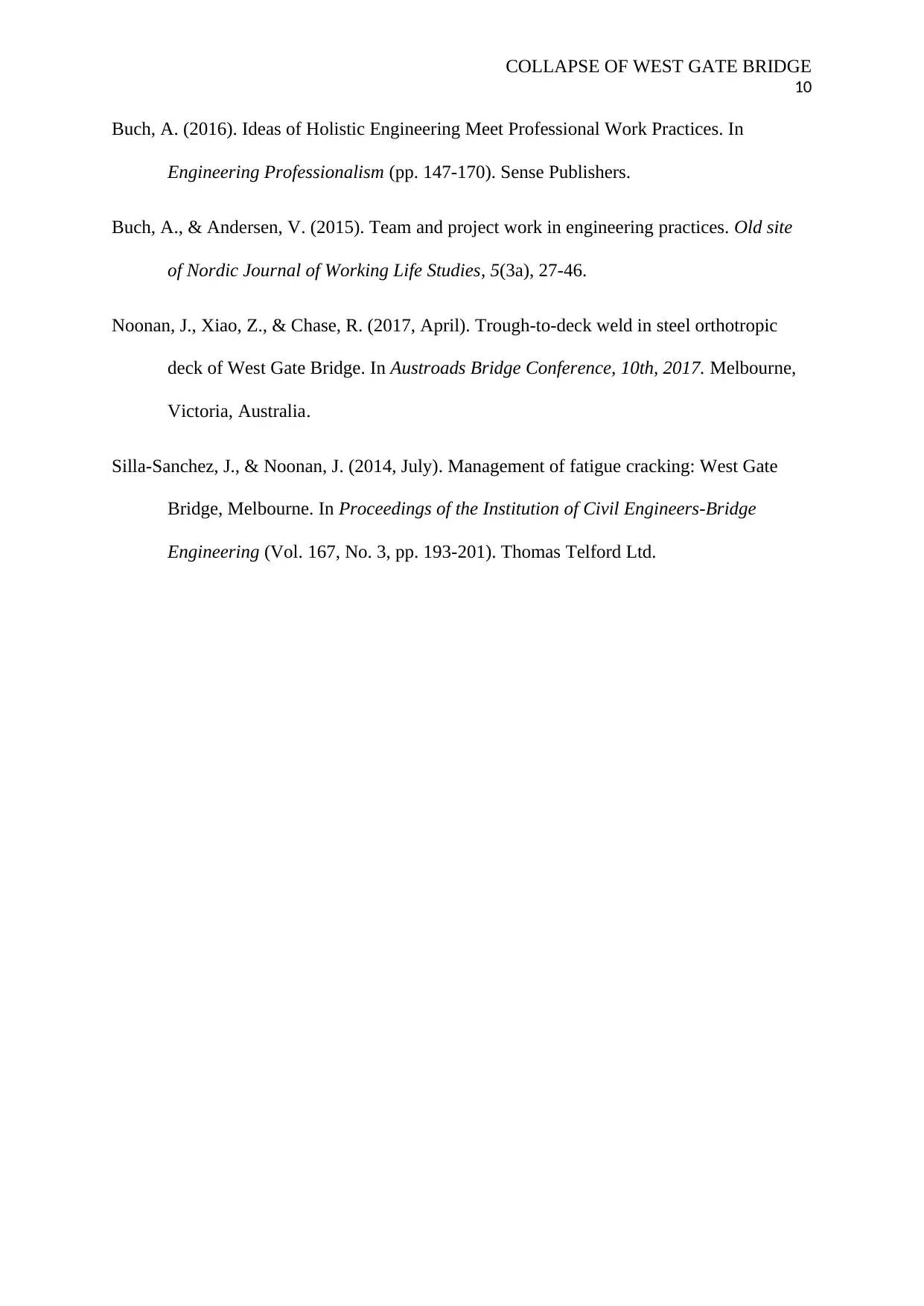
COLLAPSE OF WEST GATE BRIDGE
10
Buch, A. (2016). Ideas of Holistic Engineering Meet Professional Work Practices. In
Engineering Professionalism (pp. 147-170). Sense Publishers.
Buch, A., & Andersen, V. (2015). Team and project work in engineering practices. Old site
of Nordic Journal of Working Life Studies, 5(3a), 27-46.
Noonan, J., Xiao, Z., & Chase, R. (2017, April). Trough-to-deck weld in steel orthotropic
deck of West Gate Bridge. In Austroads Bridge Conference, 10th, 2017. Melbourne,
Victoria, Australia.
Silla-Sanchez, J., & Noonan, J. (2014, July). Management of fatigue cracking: West Gate
Bridge, Melbourne. In Proceedings of the Institution of Civil Engineers-Bridge
Engineering (Vol. 167, No. 3, pp. 193-201). Thomas Telford Ltd.
10
Buch, A. (2016). Ideas of Holistic Engineering Meet Professional Work Practices. In
Engineering Professionalism (pp. 147-170). Sense Publishers.
Buch, A., & Andersen, V. (2015). Team and project work in engineering practices. Old site
of Nordic Journal of Working Life Studies, 5(3a), 27-46.
Noonan, J., Xiao, Z., & Chase, R. (2017, April). Trough-to-deck weld in steel orthotropic
deck of West Gate Bridge. In Austroads Bridge Conference, 10th, 2017. Melbourne,
Victoria, Australia.
Silla-Sanchez, J., & Noonan, J. (2014, July). Management of fatigue cracking: West Gate
Bridge, Melbourne. In Proceedings of the Institution of Civil Engineers-Bridge
Engineering (Vol. 167, No. 3, pp. 193-201). Thomas Telford Ltd.
1 out of 10
Your All-in-One AI-Powered Toolkit for Academic Success.
+13062052269
info@desklib.com
Available 24*7 on WhatsApp / Email
![[object Object]](/_next/static/media/star-bottom.7253800d.svg)
Unlock your academic potential
Copyright © 2020–2025 A2Z Services. All Rights Reserved. Developed and managed by ZUCOL.